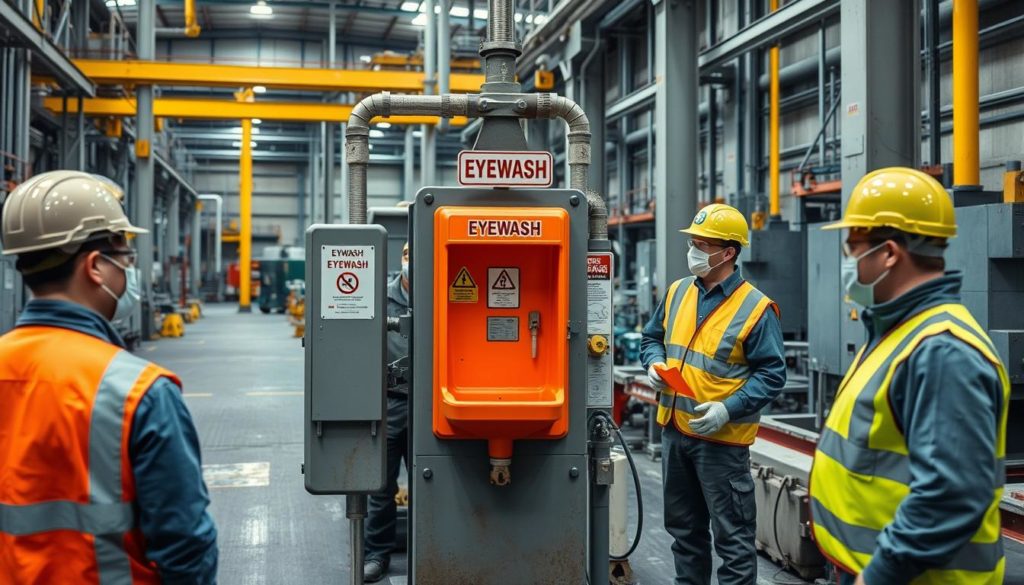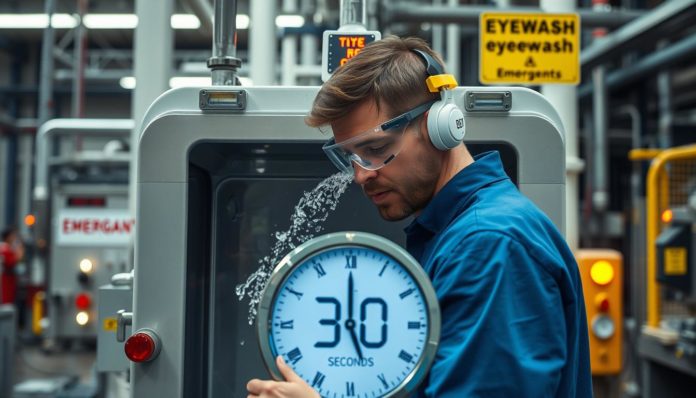Did you know over 2,000 American workers get eye injuries every day that need medical help? Taking steps to make your workplace safe, like putting in a good eyewash station, can really cut down on these risks. It’s crucial to have a quick and right emergency response for eye safety to keep workers safe and follow the rules.
Having eyewash stations that are put in right and checked often is key. They make sure you’re following the rules and give your workers and bosses more confidence. Cintas points out that having reliable eyewash stations is a game-changer in emergencies. Check out our full guide to see how you can make your workplace safer for eyes.
Importance of Eyewash Stations in the Workplace
Having emergency eye wash facilities at work is key for keeping employees safe and healthy. These stations help quickly treat eye injuries, preventing serious harm.

Immediate Response to Eye Injuries
Quick first aid is vital for eye injuries, especially from dangerous substances. With emergency eye wash stations, workers get fast and right treatment. This helps avoid serious problems. ANSI standards for workplace safety say eyewash stations should be just 10 seconds away from danger zones.
Compliance with Safety Regulations
Following OSHA eyewash station requirements is a must for safety. It shows a company cares about its workers’ health. These rules help lower risks and handle dangers well.
Peace of Mind for Employers and Employees
Having the right eyewash stations gives everyone peace of mind. When a workplace meets ANSI standards for workplace safety, it shows it values its staff’s safety. This creates a safe place to work and builds trust among employees and management.
Understanding Emergency Eyewash Stations
Emergency eyewash equipment is key for eye safety at work. Knowing the different types and what they offer can help in emergencies. This knowledge can make a big difference in how quickly you can respond.
Types of Eyewash Stations
There are several main eyewash unit types to think about when choosing the right one for your place:
- Sink-mounted units: These have two orifices and are directly connected to a water supply, offering a continuous flow of water.
- Wall-mounted units: Often in locations lacking immediate sink access, providing ergonomic and strategic placement.
- Portable units: Suitable for spaces where plumbing isn’t readily available, ensuring mobility and flexibility.

Features of Effective Eyewash Units
For emergency eyewash equipment to work well, it must have certain safety equipment features:
- Hands-free operation: Permits users to keep their hands free while flushing their eyes, enhancing safety and ease of use.
- Protective caps: These should be easy to remove, ensuring quick access and maintaining the sanitary condition of the nozzles.
- Consistent water flow: A continuous, controlled water flow is essential for thorough decontamination.
Using top-notch emergency eyewash units with these features means you can give quick and proper care during eye injuries. This can lessen harm and make the workplace safer.
ANSI Eyewash Guidelines: What You Need to Know
Ensuring workplace safety is key, and that means knowing about eyewash station placement and safety checks. The ANSI Z358.1-2014 standard is vital for keeping these emergency tools ready and easy to find. It covers where to put them, how they should work, and how to keep them in good shape.
Location and Accessibility Requirements
The ANSI Z358.1-2014 standard says eyewash stations must be within 10 seconds or about 55 feet from hazards. This makes sure people can get to them fast in an emergency, reducing eye injury risks. Plus, the way to these stations should be clear of any blocks so people can move quickly.
Operational Standards
Keeping eyewash stations ready is crucial. The ANSI Z358.1-2014 standard requires them to flow clean water for at least 15 minutes without stopping. They should be easy to start and work without help after starting. Regular checks make sure they’re always ready to go.
Inspection and Maintenance Protocols
Following the ANSI Z358.1-2014 standard, checking safety gear often is a must. Every month, inspect the station to make sure the water flows right and is not too hot. Fix any problems right away to keep the eyewash units working well. These checks help make sure they’re ready for emergencies and stop problems before they start.
Best Eyewash Practices for Safety Compliance
To keep the workplace safe, it’s key to teach employees how to use eyewash stations. This training prepares them for eye emergencies. We’ll look at important training points and how to use the stations right.
Training and Education for Employees
It’s vital to train employees for emergencies. They should learn how to use eyewash stations quickly and correctly. This training builds their confidence in dealing with eye incidents.
Proper Usage Techniques
Knowing how to use eyewash stations is crucial. Employees must flush their eyes for 15 minutes, even if they feel better early. Also, removing contact lenses helps prevent more irritation. This knowledge is key to following safety rules at work.
Eye Safety Procedures in Hazardous Environments
Keeping eyes safe in dangerous places is very important. We must identify and prevent eye hazards to keep the workplace safe.
Identifying Potential Eye Hazards
First, we look for risks like harmful substances in the workplace. Oregon-OSHA says we need eyewash stations near these dangers.
Implementing Preventative Measures
After spotting hazards, we take steps to prevent them. This means making sure eyewash stations are easy to reach. It also means training everyone on how to use safety gear correctly.
Let’s look at what makes a good eye safety plan:
| Component | Description | Benefit |
|---|---|---|
| Eye Hazard Identification | Assess workplace for potential risks | Minimizes risk of eye injury |
| Eyewash Station Accessibility | Ensure stations are unobstructed | Provides immediate help for eye injuries |
| Regular Testing | Check safety gear often | Makes sure gear works right |
| Employee Training | Teach staff how to use safety gear | Makes the workplace safer for everyone |
With these steps, workers are safer, and the workplace meets safety standards.
Comprehensive Eyewash Solutions Guide
Creating a strong emergency eyewash guide is key to safety and following the rules. It’s important to pick the right equipment and install it correctly. Knowing the signs of chemical exposure and how to use emergency showers and eyewash stations together is crucial.
Getting ready for emergencies means having clear steps for quick emergency preparation and reporting. This includes:
- Training all employees on how to use the equipment right
- Checking and maintaining the units regularly
- Following all safety laws
Here’s a quick guide to eyewash solutions:
| Component | Description |
|---|---|
| Equipment Selection | Pick units that fit your work area well. |
| Installation | Install correctly so it’s easy to use and works well. |
| Training | Make sure everyone knows how to use it and what to do in an emergency. |
| Maintenance | Check regularly to keep everything in top shape. |
| Compliance | Follow all safety rules and standards. |
Eyewash Station Maintenance and Inspection
Checking eyewash stations often is key for ensuring safety equipment functionality and following the rules. It means sticking to strict standards and keeping up with a detailed checklist.
Frequency of Inspections
It’s important to check eyewash stations often. You should do weekly checks to make sure everything works right. Also, have an annual check by experts like EH&S.
Steps to Ensure Functionality
Here are the main steps for inspecting eyewash stations:
- Check the cleanliness of nozzle caps.
- Make sure the eyewash nozzles have the right flow rate.
- Keep detailed records of each inspection using a maintenance checklist.
- Fix problems like blocked nozzles or bad water flow right away.
Common Maintenance Issues and Resolutions
Common problems include blocked nozzles, dirty parts, and issues with water flow. Fixing these quickly is key for ensuring safety equipment functionality. Here’s what to do:
| Common Issues | Resolutions |
|---|---|
| Blocked Nozzles | Clear them out and check often |
| Compromised Water Flow | Adjust the flow rate as needed, following ANSI standards |
| Dirty Nozzle Caps | Clean them regularly and check for dirt |
| Documentation Gaps | Use a detailed checklist for consistent records |
Following these steps will keep your eyewash stations ready and in line with the rules at all times.
First Aid for Eye Injuries: A Step-by-Step Guide
Eye injury first aid is key to reducing damage and helping with recovery. Accidents can happen suddenly, and knowing how to react can really help. Whether it’s a chemical spill or something in your eye, acting fast and right is important.
Immediate Actions to Take
First, use an eyewash station to clean the eyes with water. Make sure the water keeps flowing over the eyes for at least 15 minutes. Also, take out any contact lenses to let the water clean the eye fully.
These steps are crucial to remove harmful substances from the eyes.
When to Seek Medical Attention
If you’ve done first aid and think you might have been exposed to a corrosive chemical, you should get medical help. Look at the Safety Data Sheets for info on the chemical and tell the right authorities about the incident. For more help on what to do in eye emergencies, check out the Mayo Clinic’s guide on first aid for.
FAQ
What is the importance of eyewash stations in the workplace?
Eyewash stations are key for handling eye injuries at work, especially with dangerous chemicals. They clean the eyes right away and prevent serious harm. This makes sure workers are safe and meets legal standards.
What immediate steps should be taken during an eye injury?
If an eye gets hurt, turn on the eyewash station’s hands-free lever. Clean the eyes for at least 15 minutes and take out any contact lenses. Get medical help if needed, especially if it was a chemical burn.
Why is compliance with ANSI eyewash guidelines important?
Following ANSI eyewash rules is vital. It makes sure eyewash stations are easy to get to, work well, and are kept up. This cuts down the time from getting hurt to cleaning off the harm, making the workplace safer.
How often should eyewash stations be inspected?
Check eyewash stations every week and once a year by groups like EH&S. Keeping them clean and working right means they’re ready for emergencies.
What are the types of emergency eyewash stations available?
There are many kinds of emergency eyewash stations. You can find sink-mounted ones, portable units, and hands-free ones with easy caps. Each type is made for different places to clean eyes well in emergencies.
What are the features of an effective eyewash unit?
Good eyewash units don’t need hands, have caps that come off easily, and clean eyes well. They should be clean and always there for emergencies.
What are the key components of an eyewash solutions guide?
A good guide for eyewash solutions covers picking the right gear, setting it up, training, and keeping it up. It also talks about following the law, spotting chemical dangers, and having plans for quick action and reporting after an accident.
How can employees be trained on using eyewash stations?
Train employees often on how to use eyewash stations right. Teach them to flush eyes for 15 minutes, keep them open, and remove contact lenses. Keeping track of training helps workers be ready for eye emergencies.
What should be done if an eyewash station is found to be non-functional?
If an eyewash station doesn’t work, fix it right away. Clean out any blockages or fix the water flow. Make sure it works again fast.
When should further medical attention be sought after using an eyewash station?
After using an eyewash station, check if you need more medical help, especially if it was a chemical burn. Use Safety Data Sheets and tell the right people about the accident quickly.


